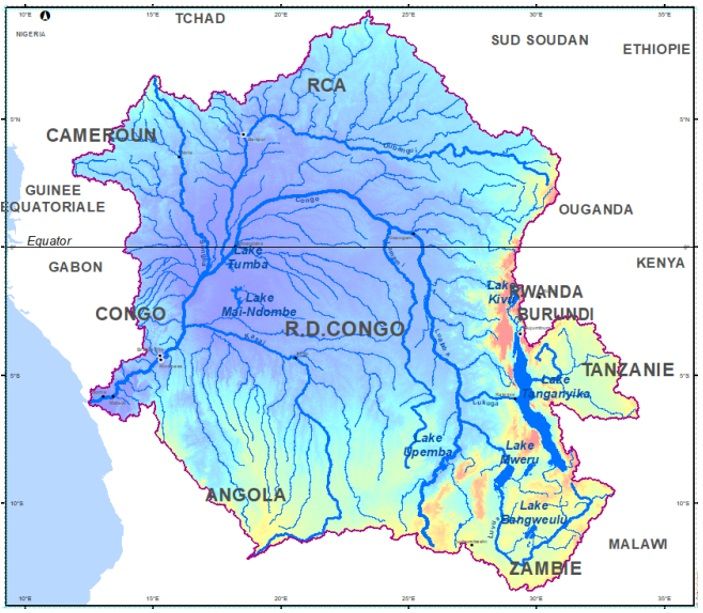Context and justification
Fresh water is globally recognised as fundamental to all forms of life, including human endeavors and the ecosystem. Not only is water a basic need, but adequate safe water underpins the nation’s health, economy, security, and environment. In the coming decades, no natural resource may prove to be more critical to societal needs and environment than water. The strategic challenge for the future is therefore to ensure adequate quantity and quality of water to meet the growing needs among competitive domestic, industrial, commercial, agricultural, and environmental uses.

The Congo Basin is located in Africa and is shared by nine riparian countries. Water resources management in the Congo Basin faces problems of lack of data and technical resources, as well as the magnitude of their corollaries. This constitutes an obstacle to the formulation of adequate management strategies, necessary for the development of water resources, as well as to deal with the impacts of land occupation and climate change.
There is evidence that water resources in many parts of the Congo River Basin are deteriorating. Our institutions appear to have limited capacity to manage these resources and provide adequate services. Demands for water resources to support socio-economic growth continue to increase, although quality services to meet these demands are largely lagging behind. These demands are not only expected from the nine riparian countries, but also from other water scarce regions across Africa. From a study on opportunities for hydrologic research in the Congo Basin (http://onlinelibrary.wiley.com/doi/10.1002/2016RG000517/full), the authors suggested an array of research hypotheses that meet some major questions about the dynamics of water resources in the Congo Basin. These hypotheses focus on: the source of the Cuvette’s waters and how these leave the wetland, the river discharge generated by historic rainfall, the connection between climate change and the rainfall-runoff generated by the migrating “tropical rainbelt,” deforestation and hydroelectric power generation, and the amount of carbon emitted from Congo waters. The hypotheses virtually illustrate examples of a mounting array of water resources related problems in the region of the Congo Basin and for which scientifically sound solutions need to be found. To address water resources problems likely to emerge in the next decades, managers and decision makers at all levels will need to make informed choices among often conflicting and uncertain alternative actions. These choices are best made with the full benefit of research that provides innovative solutions.
Although the complexity and severity of water resources problems are only increasing, the necessary investments in scientific research to develop a better understanding of these resources are sorely lacking; and the few existing investments are not adequately directed. Indeed, there is no coordinated process to take into account research needs on water resources, prioritize them for funding purposes, or evaluate the effectiveness of research activities in this area. There is also no structure in place to analyze research programs generated by various expert groups such as that on achieving the Sustainable Development Goals (target 6).

As illustrated in the figure opposite, on the research results in the water sector in Africa for the period 2006-2010 (Source: GIZ, 2013), it appears that Central Africa which covers most of the Congo Basin, is the least studied compared to other regions of Africa.
Faced with the historical difficulties of implementing an effective research program on water resources, it is therefore imperative to design a mechanism to meet this need. Considering all of the above, it is necessary to create a research center to support water resources development strategies in the Congo Basin. It is in this context that the Congo Basin Water Resources Research Center (CRREBaC) was created.
This need for the creation of this center also follows the desire to perpetuate the achievements of the research work linked to the recent scientific expedition on Hydraulics and Morphology for Users of the Congo River (CRuHM), carried out from July to September 2017 by the consortium of researchers from the Universities of Kinshasa in the DRC, Dar es Salaam in Tanzania, Rhodes in South Africa, and Bristol and Leeds in the United Kingdom (Figure below). These achievements include the data collection equipment (Automatic Water Level Recorders, Automatic Sediment Samplers -ISCO-) installed in different locations along the middle reach of the Congo River and the Kasaï River, which require the monitoring and maintenance. The establishment of the center should also make it possible to extend these investigations and deepen scientific knowledge on other reaches of the Congo River.